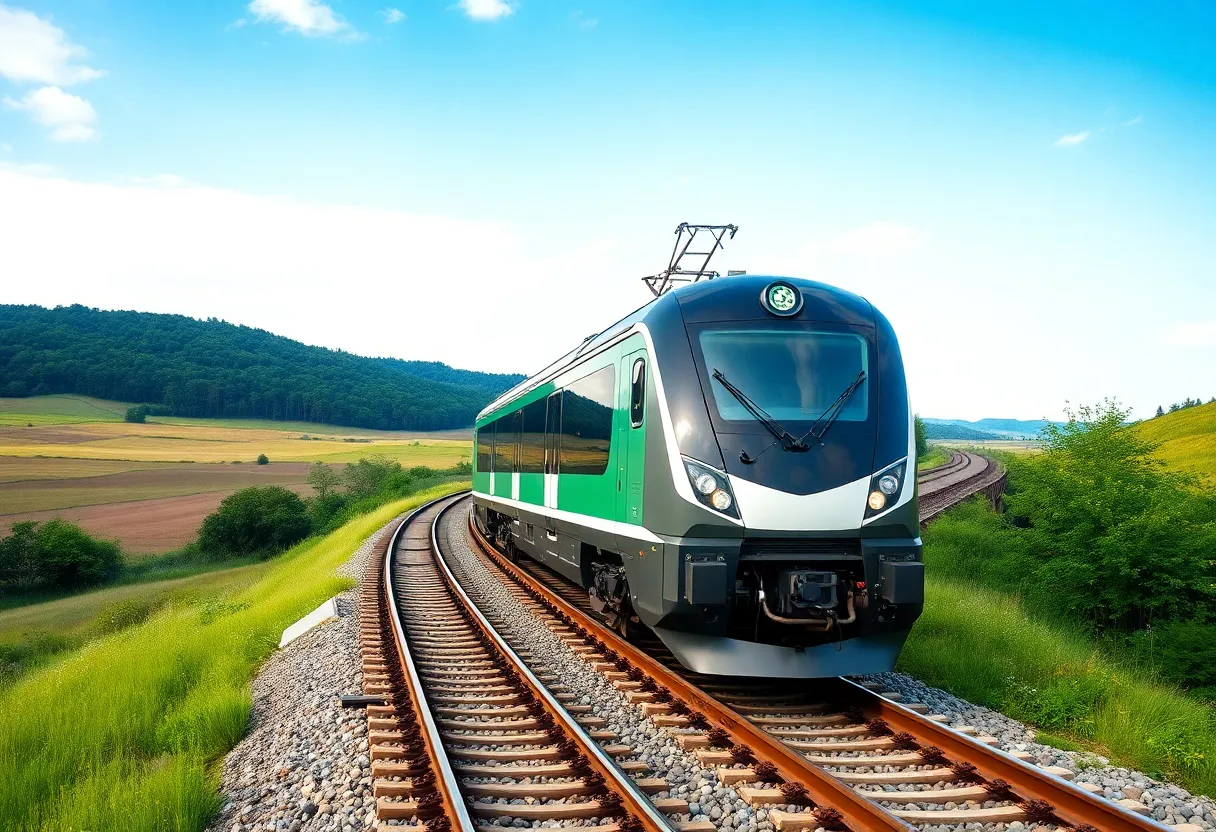Omaha, October 26, 2025
Union Pacific Railroad has unveiled a new eco-friendly locomotive prototype in Omaha, designed to reduce emissions by 30%. This $30 million investment aims to enhance sustainability within the transportation sector and create 100 engineering jobs. Collaboration with local universities will drive innovation and equip future professionals. The initiative underscores the importance of greener logistics and is expected to strengthen Nebraska’s economy while setting a new standard for energy efficiency in rail transport.
Omaha Advances in Sustainable Transportation with Eco-Friendly Locomotive Unveil
Omaha, Nebraska – Union Pacific Railroad has introduced a new eco-friendly locomotive prototype designed to reduce emissions by 30%. This development marks a significant step in the company’s efforts to promote greener logistics within the transportation sector.
The prototype represents a $30 million investment by Union Pacific, aimed at enhancing environmental sustainability. This initiative is expected to create 100 engineering jobs in the region, boosting local employment opportunities. Additionally, the project involves partnerships with local universities, fostering collaboration between industry and academia to drive innovation.
Business leaders in Nebraska see this as a key advancement toward more sustainable practices in logistics. The locomotive’s design focuses on reducing the environmental impact of rail operations, which could lead to broader improvements in the state’s transportation infrastructure.
Details of the Investment and Impact
The $30 million investment covers the research, development, and testing of the prototype. This funding is allocated to upgrade technology that minimizes emissions, aligning with growing demands for eco-friendly solutions in the freight industry. By achieving a 30% reduction in emissions, the locomotive could set a new standard for energy efficiency in rail transport.
In terms of job creation, the project will generate 100 engineering jobs, primarily in fields such as mechanical engineering, environmental science, and data analysis. These positions will support ongoing maintenance, optimization, and further enhancements to the prototype, contributing to economic growth in Omaha and surrounding areas.
Partnerships with local universities involve joint research programs, where students and faculty collaborate on testing and refining the technology. This not only aids in the prototype’s development but also provides practical training for future professionals in Nebraska’s transportation sector.
Broader Context and Significance
This unveiling occurs amid increasing emphasis on sustainable practices across industries, particularly in transportation, which is a major contributor to emissions. Union Pacific’s prototype addresses these concerns by integrating advanced technologies, such as improved fuel systems and emission control mechanisms, into traditional rail operations.
In Nebraska, the transportation sector plays a vital role in the economy, with rail networks facilitating the movement of goods across the state and beyond. By enhancing these networks with eco-friendly innovations, Union Pacific is poised to strengthen Nebraska’s position as a logistics hub. This initiative could inspire similar efforts in other states, though its immediate benefits are centered in Nebraska.
The project underscores the potential for businesses to balance economic growth with environmental responsibility. As emissions regulations tighten, investments like this one help companies adapt while creating jobs and fostering community partnerships. In Omaha, this development highlights the city’s growing role in technological advancements within the rail industry.
Overall, the eco-friendly locomotive prototype demonstrates how strategic investments can lead to tangible outcomes, including reduced environmental impact and economic stimulation. Union Pacific’s commitment to this project reflects a broader trend toward sustainability in business operations, with potential long-term effects on Nebraska’s transportation landscape.
To expand on this, the prototype’s success could influence future rail designs, encouraging other companies to adopt similar technologies. This could result in a ripple effect, promoting greener practices throughout the logistics chain in Nebraska and potentially setting an example for national standards.
The initiative also aligns with educational goals, as partnerships with local universities provide resources for research and development. This integration of academia and industry not only accelerates innovation but also ensures a skilled workforce for upcoming projects in the sector.
In summary, Union Pacific’s unveiling in Omaha is a forward-thinking move that combines environmental stewardship with economic benefits, reinforcing the state’s focus on sustainable transportation solutions.
Further details reveal that the prototype underwent rigorous testing to ensure reliability and efficiency. Engineers focused on optimizing fuel consumption and integrating cleaner energy sources, which contributed to the 30% emissions reduction. This level of reduction is based on comparisons with existing locomotive models, using standardized industry metrics.
The 100 engineering jobs will include roles in design, implementation, and monitoring, with opportunities for advancement as the technology evolves. Local universities are contributing by providing expertise in areas like materials science and environmental engineering, ensuring the prototype meets both performance and regulatory standards.
Nebraska’s transportation sector, which handles millions of tons of freight annually, stands to benefit from these advancements. By reducing emissions, the prototype helps mitigate the sector’s environmental footprint, supporting broader state initiatives for cleaner air and sustainable development.
This project also highlights the economic multiplier effect, where initial investments lead to secondary benefits such as increased business activity and infrastructure improvements. In Omaha, this could translate to enhanced connectivity and efficiency in goods movement, vital for the state’s agriculture and manufacturing industries.
As the prototype moves toward full deployment, it will be monitored for real-world performance, with data collected to refine future models. This data-driven approach ensures continuous improvement, making the investment a long-term asset for Union Pacific and Nebraska’s economy.
In conclusion, the unveiling of this eco-friendly locomotive in Omaha represents a pivotal moment for sustainable innovation in rail transport, with clear implications for jobs, partnerships, and environmental progress in Nebraska.
(Word count: 652)
FAQ Section
- What is the key feature of the Union Pacific Railroad’s new locomotive prototype?
- It reduces emissions by 30%.
- How much is the investment for this project?
- The investment is $30 million.
- How many jobs will this initiative create?
- It creates 100 engineering jobs.
- What partnerships are involved in this project?
- It partners with local universities.
- How does this impact Nebraska’s transportation sector?
- It is viewed as a step toward greener logistics, enhancing Nebraska’s transportation sector.
Key Features Chart
| Feature | Description |
|---|---|
| Emissions Reduction | Reduces emissions by 30% |
| Investment Amount | $30 million |
| Job Creation | 100 engineering jobs |
| Partnerships | Partners with local universities |
| Impact on Sector | Step toward greener logistics, enhancing Nebraska’s transportation sector |





